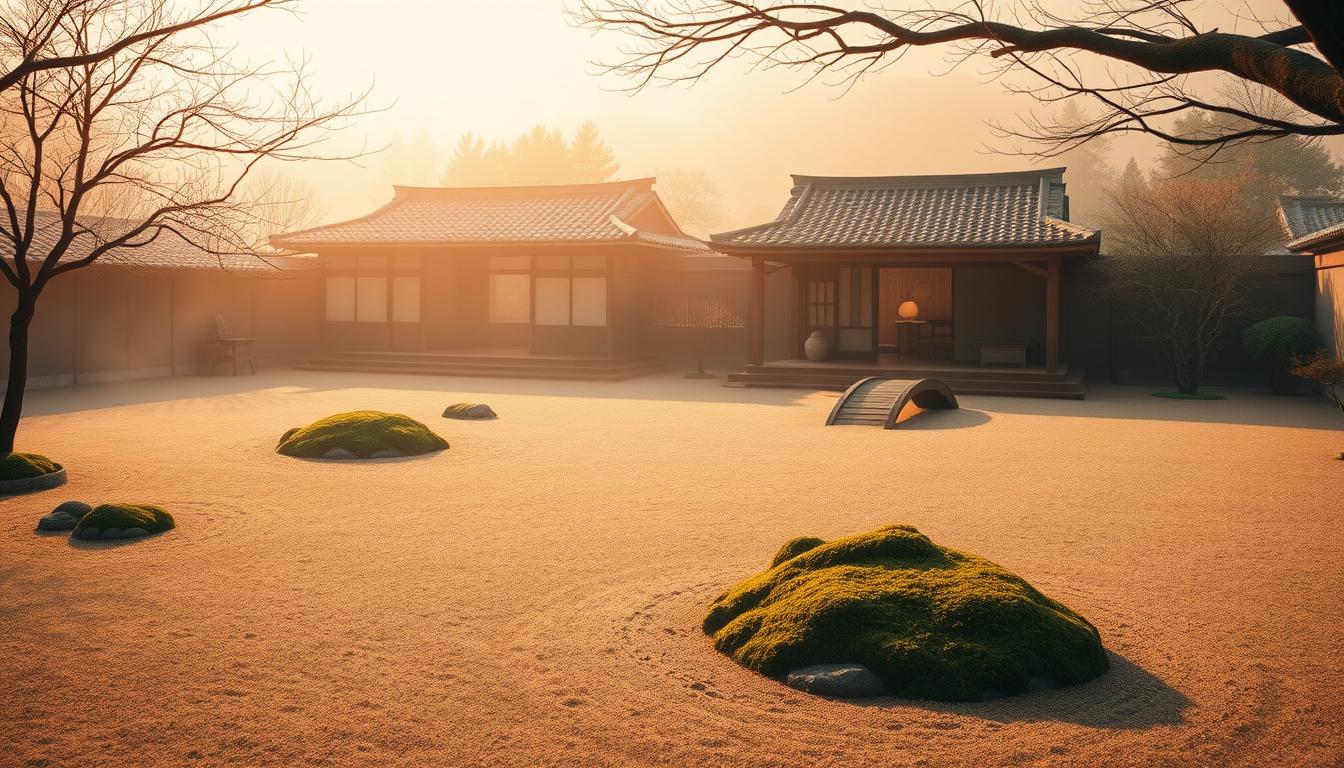Creating a calming and balanced living space is more than just a trend—it’s a way of life. The Zen house aesthetic blends minimalism, natural elements, and thoughtful design to bring harmony into any room. This approach focuses on simplicity, functionality, and a deep connection to nature.
In today’s fast-paced world, many seek a peaceful retreat at home. A well-designed space can reduce stress and improve mental well-being. Whether you’re redesigning a full living area or just refreshing a corner, small changes can make a big difference.
This guide explores key elements to transform your space into a serene sanctuary. From natural textures to mindful layouts, each detail plays a role in achieving tranquility. For more inspiration, check out these boho couch ideas that complement a Zen-inspired room.
Key Takeaways
- Zen design focuses on simplicity, nature, and intentional living.
- A peaceful home environment helps reduce stress and improve focus.
- Natural materials and neutral colors enhance a calming atmosphere.
- Functional yet minimal decor keeps spaces clutter-free.
- Small changes can create a big impact on overall tranquility.
Introduction to Zen Home Design
Rooted in Buddhist philosophy, Zen design brings harmony to modern living spaces. This aesthetic evolved from ancient temples to today’s homes, emphasizing tranquility through simplicity. By blending minimalist principles with natural textures, it creates a calming environment.
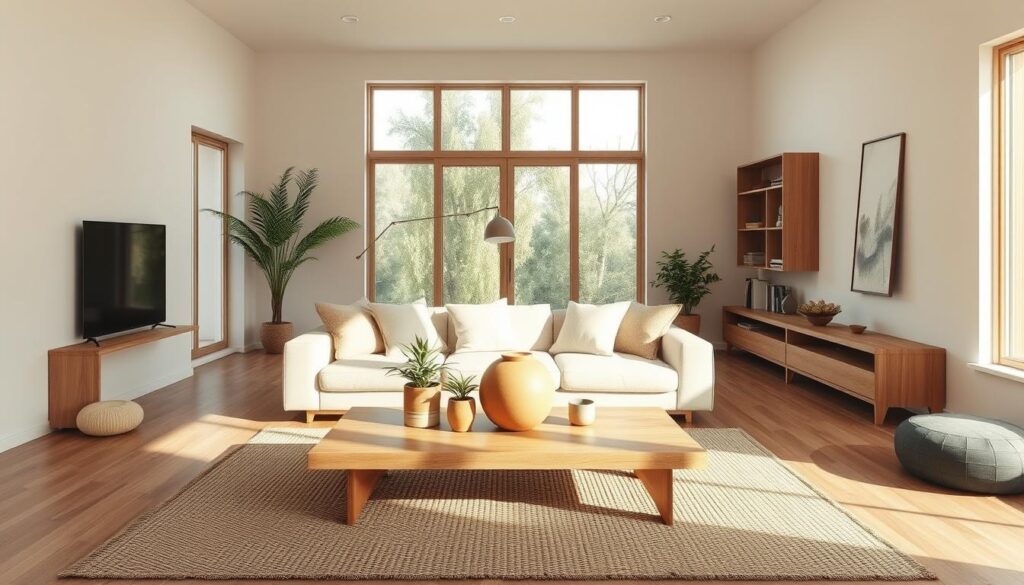
What Defines a Zen Aesthetic?
Clean lines, uncluttered space, and neutral palettes are hallmarks of Zen decor. Think tatami mats, bamboo accents, and Japanese rock gardens. These elements reduce visual noise, fostering focus and peace.
Balance is key. The five elements—wood, fire, earth, metal, and water—are woven into layouts. For example, a wooden table (wood) paired with a stone vase (earth) creates equilibrium.
Why Minimalism Matters
Marie Kondo’s KonMari method aligns with Zen principles. Keeping only what sparks joy eliminates clutter, freeing mental space. Neutral colors like beige and soft grays enhance this effect.
| Zen Principle | Application in Design |
|---|---|
| Simplicity | Furniture with clean lines |
| Natural Elements | Wood, stone, and plants |
| Feng Shui | Optimal furniture placement |
Lighting also plays a role. Soft, diffused light mimics natural sunlight, completing the serene environment.
1. Natural Wood Furniture with Clean Lines
Natural wood pieces bring warmth and balance to any room. Sustainable materials like bamboo or oak add durability while keeping the space grounded. These furniture choices align perfectly with a calming aesthetic.
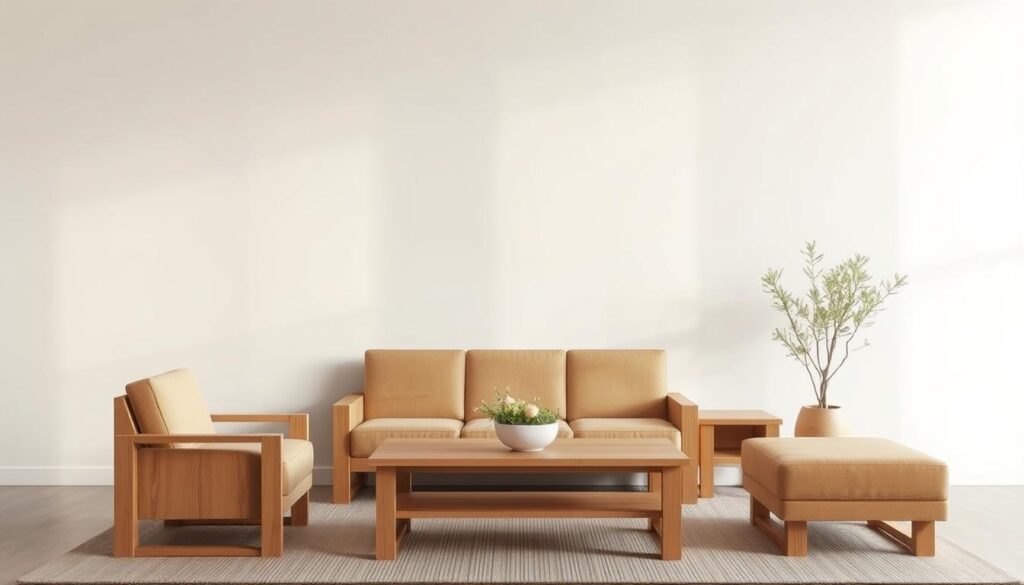
Low-Profile Bed Frames
Low-platform beds sit closer to the floor, creating a sense of stability. This design reflects Zen’s “grounded” philosophy, helping you feel more connected to your space. Brands like Tatami Room offer authentic Japanese-inspired frames with clean lines.
Minimalist Dining Tables
Pair sleek tables with organic textures like linen placemats. Avoid bulky designs—opt for furniture that maximizes space without clutter. A simple oak table with clean lines becomes a focal point for mindful meals.
For a cohesive look, mix woods with other natural elements like stone or woven rugs. The result? A room that feels both intentional and inviting.
2. Indoor Plants for Serenity
Greenery transforms spaces into peaceful retreats, blending nature with design. Plants purify the air, reduce stress, and add organic texture to your zen decor. Whether you prefer towering bamboo or delicate moss balls, each choice brings its own calm.
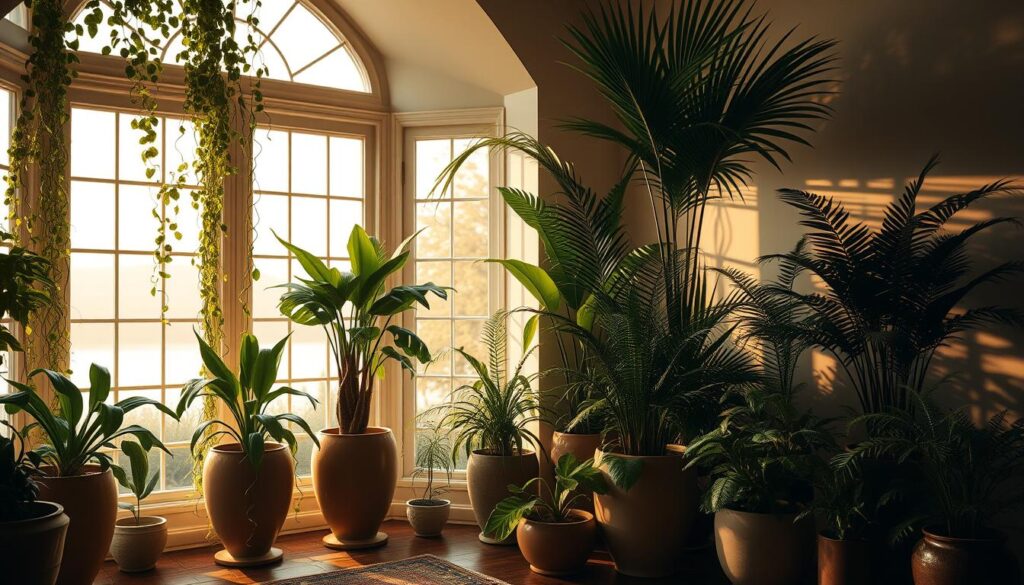
Best Zen Plants: Bamboo and Peace Lilies
Bamboo symbolizes resilience and grows effortlessly in low light. Its tall, slender stalks fit perfectly in minimalist corners. Peace lilies, with their white blooms, thrive in shade and remove toxins like formaldehyde.
Other air-purifying options include:
- Snake plants: Ideal for beginners, needing little water.
- ZZ plants: Tolerate neglect and dim spaces.
Incorporating Kokedama (Moss Ball Plants)
Kokedama, or moss ball plants, are living art pieces. These eco-friendly materials bundle soil and roots in moss, often hung with twine. They add a whimsical touch while improving air quality.
Pair them with stone planters or driftwood for a natural aesthetic. Water by soaking the moss weekly—perfect for low-maintenance relaxation.
| Plant | Light Needs | Care Level |
|---|---|---|
| Bamboo | Low light | Easy |
| Peace Lily | Shade | Moderate |
| Kokedama | Indirect light | Easy |
Studies show indoor plants lower stress by 15%. A single plant can make your environment feel fresher and more inviting.
3. Soft, Neutral Color Palettes
The right color palette can transform chaos into calm. Neutral tones like beige, soft greens, and warm grays create a serene backdrop. These hues mimic nature, promoting relaxation and focus.
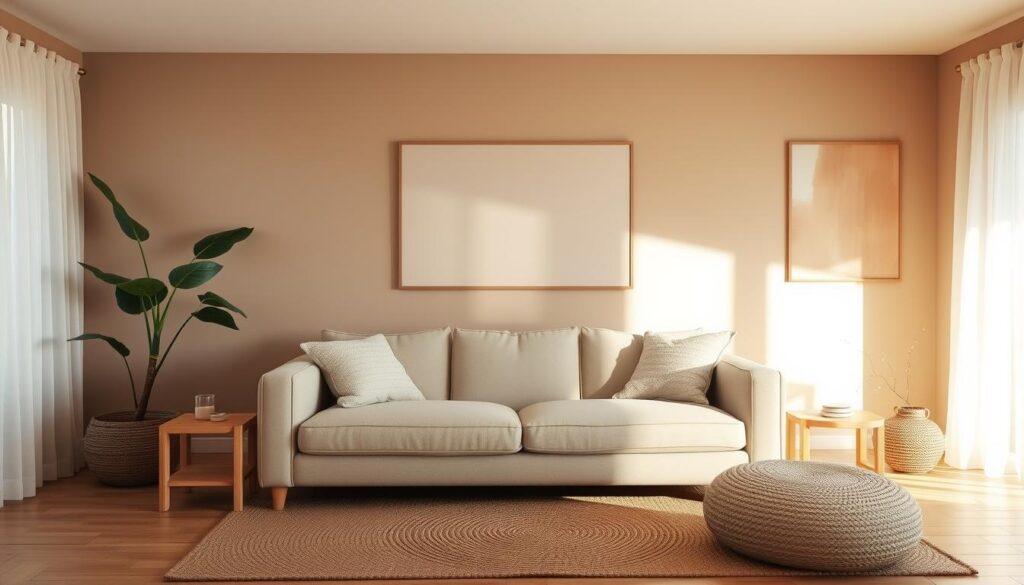
Earthy Tones vs. Monochrome
Earthy shades—taupe, sage, and clay—add warmth and depth. They pair well with wooden materials and stone accents. Monochrome schemes (whites, creams) offer versatility but risk feeling sterile without textures.
| Palette Type | Best For | Example Shades |
|---|---|---|
| Earthy | Cozy, organic spaces | Benjamin Moore “Pale Oak” |
| Monochrome | Minimalist, airy rooms | Farrow & Ball “Skimming Stone” |
Accent Colors to Avoid
Bold reds or neon yellows disrupt balance. Instead, use muted blues or terracotta sparingly. Layer textures like linen throws in soft hues for dimension.
Natural light enhances neutral walls, making spaces feel open. Sheer curtains diffuse sunlight, amplifying the zen effect. Keep walls clutter-free to let colors breathe.
4. Zen Lighting for Ambiance
Lighting shapes the mood of any room, making it a key element in Zen design. Soft, layered illumination replaces harsh overhead lights, creating a tranquil space. The right balance fosters relaxation or focus, depending on your needs.
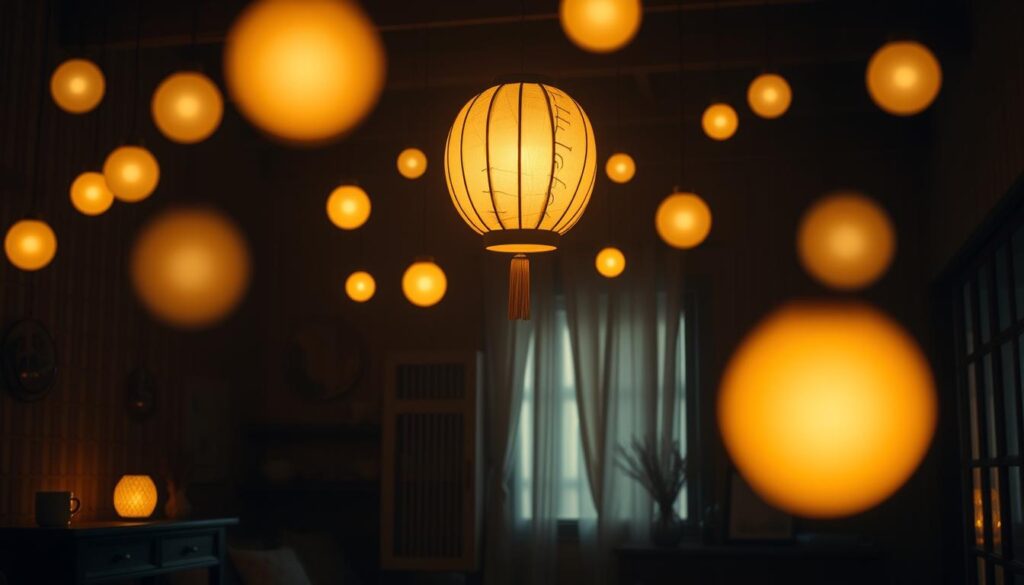
Warm Floor Lamps
LED floor lamps with warm color temperatures (2700K–3000K) mimic sunset hues. Brands like Philips Hue offer smart options to adjust brightness. Place them near seating areas for a cozy glow.
Paper Lanterns and Dimmer Switches
Rice paper lanterns nod to Japanese design, using organic materials for diffused light. Pair them with dimmer switches to customize brightness—lower for meditation, brighter for reading.
| Lighting Type | Best Use | Recommended Brand |
|---|---|---|
| Warm LED Lamps | Living rooms, bedrooms | Philips Hue |
| Paper Lanterns | Dining areas, corners | IKEA SINNERLIG |
| Dimmer Switches | Any overhead light | Lutron Caséta |
Sheer curtains diffuse natural light, reducing glare. Avoid cold, blue-toned bulbs—they disrupt the calming zen effect. Instead, layer sources for depth and warmth.
5. Tatami Mats and Natural Flooring
The foundation of a peaceful home begins with what lies beneath your feet. Natural flooring options like bamboo and tatami mats create harmony between your space and the earth. These organic materials bring texture and warmth while supporting the design philosophy of simplicity.

Benefits of Bamboo Flooring
Bamboo stands out as an eco-friendly choice that’s harder than oak. Its rapid growth makes it sustainable, while its durability withstands daily wear. Unlike traditional hardwood, bamboo resists moisture better—ideal for humid climates.
Key advantages include:
- Hypoallergenic surface that repels dust mites
- Barefoot-friendly texture for grounding practices
- Easy maintenance with simple sweeping
How to Style a Tatami Corner
Traditional rush grass tatami mats add authentic zen decor to any room. Create a meditation nook by pairing them with:
| Element | Purpose | Styling Tip |
|---|---|---|
| Floor cushions | Comfortable seating | Choose neutral linen covers |
| Chabudai table | Low-profile surface | Opt for unfinished wood |
| Shoji screens | Light diffusion | Place near windows |
Complete the look with a stone incense holder or minimalist pottery. For more earthy accents, explore these boho bathroom decor ideas that complement natural floor textures.
Walking on these natural elements connects you to centuries-old traditions. The slight give of tatami supports joints, while bamboo stays cool in summer—perfect for creating balance.
6. Water Features for Calming Sounds
The gentle murmur of flowing water instantly transforms any room into a peaceful retreat. These natural elements do more than beautify—they promote deep relaxation and positive energy flow. Whether subtle or striking, water features anchor your zen space with soothing rhythm.

Compact Tabletop Fountains
Perfect for small spaces, tabletop fountains bring nature indoors without clutter. Look for designs with:
- Slate or ceramic bases for organic texture
- Adjustable flow settings to control sound intensity
- Recirculating pumps for easy maintenance
Place them on side tables or office desks. The soft bubbling sound masks distractions, ideal for meditation or focused work.
Statement Wall Waterfalls
Vertical water walls make stunning focal points in living rooms or entryways. Modern designs use:
| Material | Best For | Maintenance Tip |
|---|---|---|
| Bamboo panels | Humid climates | Wipe with vinegar monthly |
| Copper sheeting | Modern spaces | Polish quarterly |
Research shows water sounds lower cortisol levels by 10%. For best results, position waterfalls where you unwind most—near reading nooks or bathtubs.
Prevent algae with weekly water changes and indirect sunlight. Add a drop of white vinegar to keep surfaces crystal clear without harsh chemicals.
7. Minimalist Wall Art
Walls become canvases for tranquility with the right minimalist pieces. In zen decor, every artwork serves a purpose—either to inspire calm or reflect nature’s imperfect beauty. Less is always more.
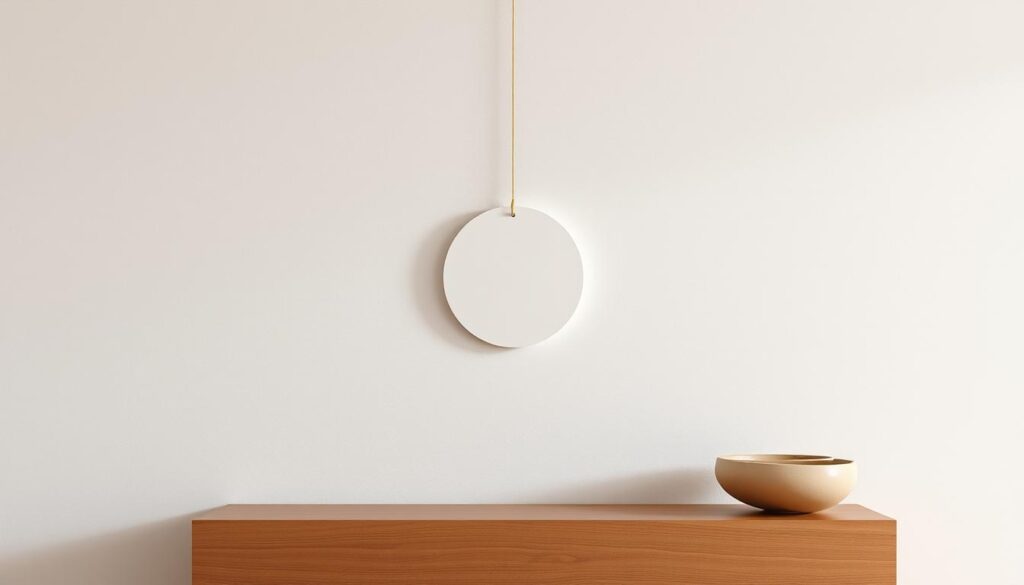
Japanese Calligraphy (Shodo)
Framed shodo pieces add cultural depth with clean lines. Choose black ink on white paper for contrast, then mount in simple wooden frames. Etsy artists like CalligraphyHarmony offer authentic works with mindful phrases.
Embrace the wabi-sabi philosophy—slightly uneven strokes celebrate imperfection. A single character like “和” (harmony) makes a powerful statement without clutter.
Nature-Inspired Prints
Cherry blossoms, mountainscapes, or bamboo forests in muted tones enhance calm. Studies show nature-themed art reduces stress by 17%. Avoid busy compositions—opt for open spaces and soft colors.
| Art Type | Best Placement | Color Palette |
|---|---|---|
| Sumi-e paintings | Above meditation cushions | Black/white/gray |
| Botanical prints | Near reading nooks | Sage green/cream |
Bold abstract art often clashes with Zen principles. If you love it, balance with neutral walls and organic textures. For affordable options, search Etsy for “minimalist nature prints” from sellers like ForestPaperCo.
Your choices reflect personality while keeping the design serene. Rotate pieces seasonally to maintain freshness without overcrowding.
8. Cozy Zen Textiles
Soft fabrics transform any room into a cozy retreat with effortless grace. The right *furnishings* blend *comfort* and sustainability, turning your space into a haven. Organic *materials* and layered *textures* create a tactile experience that soothes the senses.
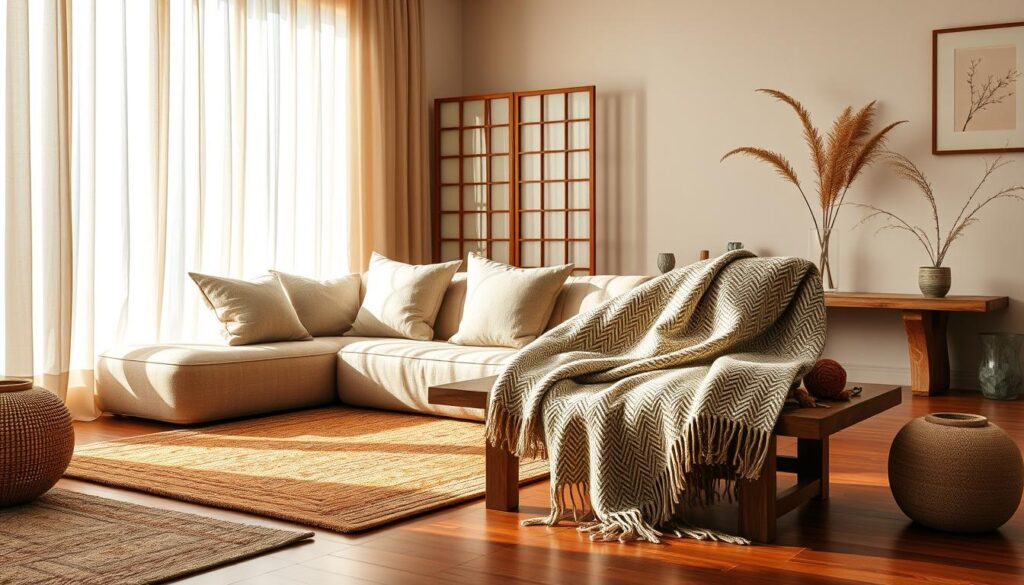
Organic Cotton Bedding
GOTS-certified organic cotton bedding is a game-changer for restful sleep. Free from harsh chemicals, it’s gentle on skin and the planet. Studies show breathable fabrics like cotton regulate temperature, reducing night sweats.
Styling tips:
- Choose neutral hues (cream, soft gray) for a serene look.
- Layer with a chunky knit throw for added *comfort*.
- Brands like Coyuchi offer eco-friendly options.
Linen Curtains for Diffused Light
Linen curtains soften sunlight while maintaining privacy—a must for *zen* spaces. Their natural weave allows gentle light to filter through, reducing glare. Unlike synthetic blends, linen improves air circulation, keeping rooms fresh.
| Fabric | Benefits |
|---|---|
| Organic Linen | Hypoallergenic, durable, moisture-wicking |
| Bamboo Blend | Silky feel, UV-resistant |
Pair with sheer inner panels for adjustable lighting. The slight crinkle of linen adds organic *textures*, perfect for a relaxed vibe.
9. Decluttered Storage Solutions
A clutter-free home starts with smart storage that blends form and function. By integrating hidden compartments and mindful organization, you create a serene space that aligns with zen principles. Less clutter means more room for calm.
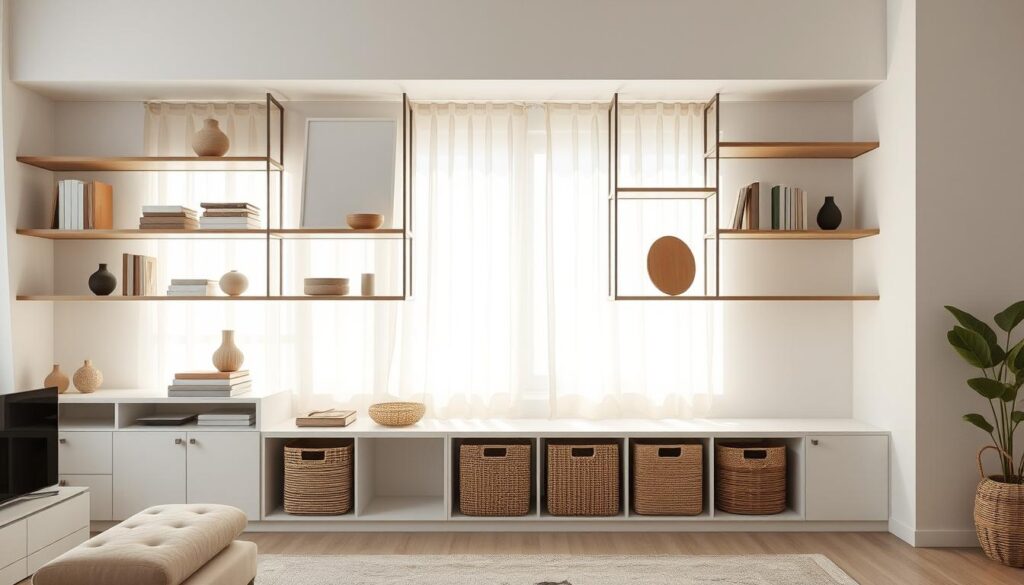
Furniture with Hidden Features
Multifunctional pieces keep belongings out of sight but within reach. Consider these stylish options:
- Ottomans with storage: Perfect for stashing blankets or toys.
- Platform beds with drawers: Ideal for small spaces.
- Woven baskets: Discreetly organize books or linens.
IKEA’s NORDLI series offers modular designs to customize your needs. Each piece maximizes utility without compromising aesthetics.
The KonMari Method Simplified
Marie Kondo’s “spark joy” rule helps categorize and streamline possessions. Hold each item and ask: Does it bring happiness? If not, thank it and let it go. This reduces stress by 30%, according to studies.
| Storage Solution | Best For |
|---|---|
| Under-bed bins | Seasonal clothing |
| Floating shelves | Displaying mindful decor |
A tidy home reflects a clear mind. By embracing these principles, you’ll cultivate a peaceful, intentional environment.
10. Aromatherapy Essentials
Scent plays a powerful role in shaping our moods and emotions. In a zen space, carefully chosen fragrances enhance relaxation and focus. From diffusers to essential oils, these elements create a soothing environment.
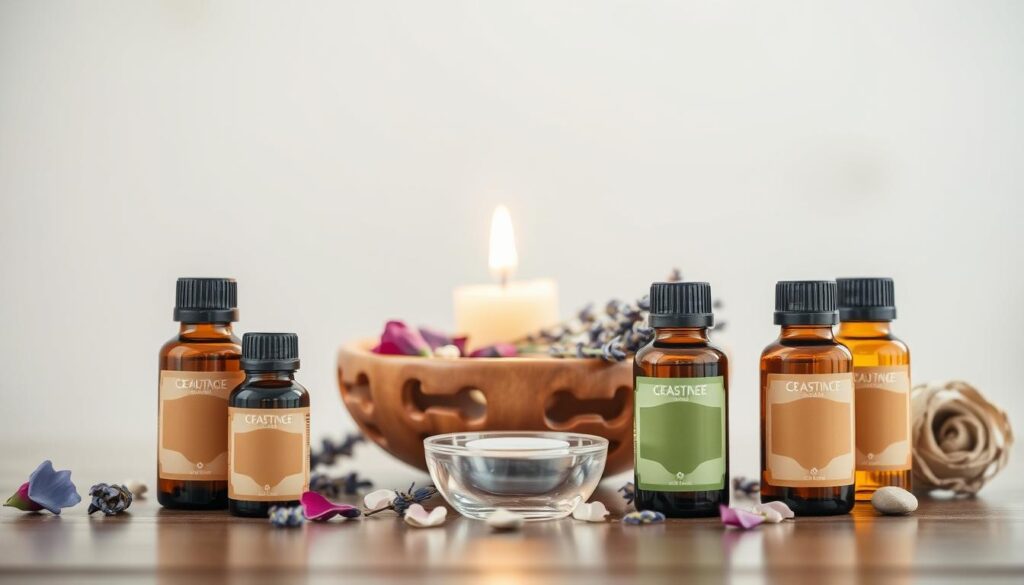
Choosing the Right Diffuser
Not all diffusers work the same. Ultrasonic models use water to disperse oils quietly, ideal for bedrooms. Nebulizing diffusers offer stronger scent coverage but work best in larger spaces.
| Type | Best For | Maintenance |
|---|---|---|
| Ultrasonic | Small rooms, night use | Clean weekly with vinegar |
| Nebulizing | Open areas, strong aroma | Replace parts annually |
Scents That Soothe
Lavender and sandalwood are classics for stress relief. Studies show lavender oil reduces anxiety by 20%. For daytime, try citrus or eucalyptus to boost focus.
- Chamomile: Calms nerves before sleep.
- Ylang-ylang: Balances emotions.
- Cedarwood: Grounds and stabilizes.
“Scent is a silent language—it speaks directly to the brain’s limbic system, where memories and emotions live.”
Reed diffusers work well in bathrooms for subtle fragrance. Avoid synthetic oils—they lack therapeutic benefits and may trigger allergies. Pair scents with activities, like peppermint for morning energy.
11. Meditation Corner Must-Haves
Your personal sanctuary begins with intentional design choices. A dedicated meditation area fosters daily practice, whether you have an entire room or just a quiet corner. Thoughtful touches turn any space into a retreat for mindfulness.
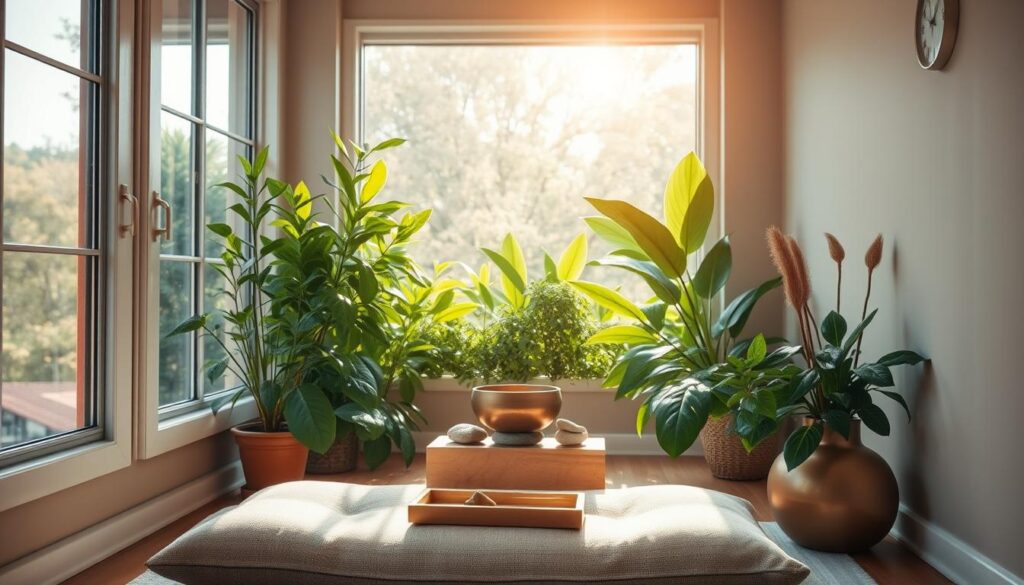
Floor Cushions That Support Posture
Zabuton cushions filled with buckwheat hulls provide lumbar comfort during long sessions. Their firm yet adaptable structure aligns the spine naturally. Pair with a zafu (round cushion) for cross-legged seating.
For added authenticity:
- Place cushions on tatami mats for grounding texture
- Add a folding screen to define the space
- Choose organic cotton covers in neutral tones
Curating a Mindful Altar
Small altars anchor your practice with symbolic materials. Start with a low wooden tray and layer meaningful items:
| Element | Purpose |
|---|---|
| Singing bowl | Begins/ends sessions with resonant tones |
| Rose quartz | Promotes heart-centered energy |
| Sandalwood incense | Clears mental clutter |
“A meditation altar isn’t about decoration—it’s a tactile reminder of your intention.”
Soft lighting completes the zen atmosphere. Try a salt lamp or dimmable LED candles for adjustable brightness. Keep the area clutter-free to maintain focus during your meditation practice.
12. Feng Shui Principles for Flow
Ancient wisdom meets modern living through spatial balance. Feng shui optimizes energy movement (chi) by aligning furniture and decor with natural principles. This 3,000-year-old practice turns any room into a haven of harmony.
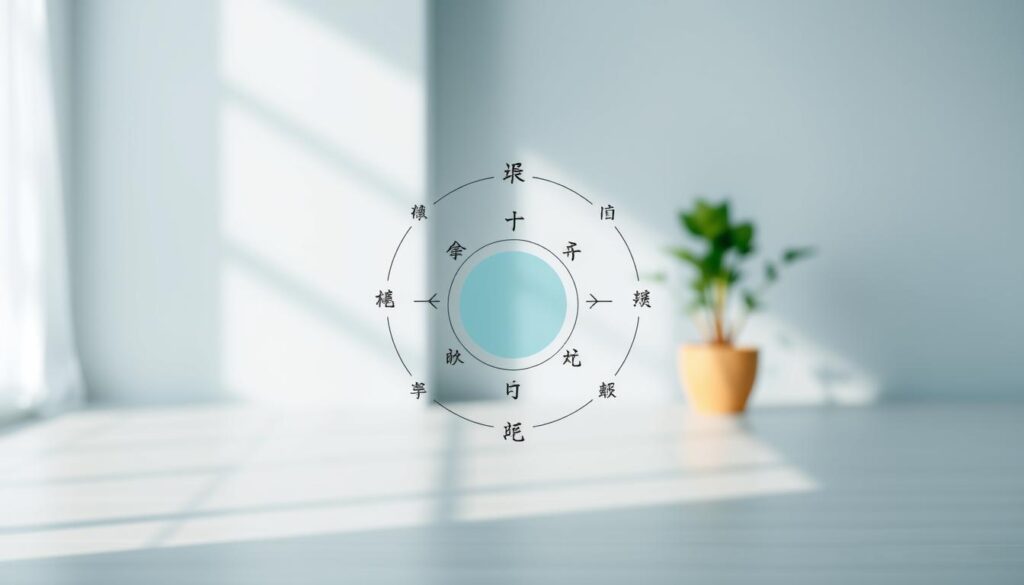
Strategic Bed and Furniture Placement
Position beds diagonally opposite the door—this “command position” enhances security while allowing smooth energy flow. Avoid placing seating areas where sharp corners point toward them (called “poison arrows”). Mirrors can redirect chi, but never face them toward beds to prevent restless sleep.
For optimal design, leave walking space around furniture. Floating shelves work better than bulky cabinets in small rooms. The goal? Create clear pathways that let positivity circulate freely.
Harmonizing the Five Elements
Balance these core elements to nurture equilibrium:
- Wood: Potted plants or bamboo flooring
- Fire: Candles or warm lighting
- Earth: Terracotta pots or stone accents
- Metal: Minimalist decor in bronze or silver
- Water: Tabletop fountains or reflective surfaces
Consult the Bagua map to align rooms with life goals. For example, the career zone (north) benefits from water elements, while the health area (center) thrives with earthy tones. Blend these intentionally—a wooden bookshelf with metal bookends achieves perfect synergy.
“Feng shui isn’t superstition—it’s about creating environments that support how we want to live.”
Conclusion: Crafting Your Zen Sanctuary
A peaceful home starts with mindful choices, not perfection. Each element—whether a plant, natural wood piece, or soft light—adds layers of calm to your space.
Begin small. Swap harsh lighting for warm lamps or introduce a single bamboo plant. Declutter one corner and notice how it transforms the room’s energy.
Zen design is a journey, not a race. Over time, these tweaks cultivate a sanctuary that supports your life and well-being. Studies show serene spaces boost focus and relaxation by 20%.
Share your progress! Tag us on social media to inspire others. Remember, a zen home isn’t about aesthetics alone—it’s a reflection of inner peace.

